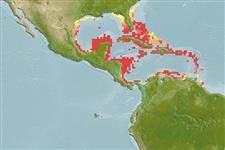>
Holocentriformes (Squirrelfishes, soldierfishes) >
Holocentridae (Squirrelfishes, soldierfishes) > Holocentrinae
Etymology: Sargocentron: Greek, sargos = sargus + Greek, kentron = sting (Ref. 45335).
More on author: Poey.
Environment: milieu / climate zone / depth range / distribution range
Ekologi
marina revassocierade; djupintervall 1 - 30 m (Ref. 9710), usually ? - 22 m (Ref. 3156). Tropical; 33°N - 7°N, 99°W - 58°W
Western Atlantic: Bermuda and Florida, USA to northern South America.
Size / Vikt / Age
Maturity: Lm ? range ? - ? cm
Max length : 15.0 cm TL hane/ej könsbestämd; (Ref. 26340)
Short description
Morfologi | Morfometri
Taggstrålar i ryggfenan (totalt): 11; Mjukstrålar i ryggfenan (totalt): 12; Taggstrålar i analfenan 4; Mjukstrålar i analfenan: 8. Body slender, sides compressed. Snout spinules prominent, spine extending into the posterior narial opening. White stripes on upper sides narrow, separated by broader dark bands (Ref. 37108). Body with alternate stripes of red and silvery white; spinous dorsal fin red, white at tips, with a large black spot between the first 3 or 4 spines (Ref. 13442).
Inhabit sandy, rocky and coral bottoms (Ref. 5521). More common on seaward reefs than on protected reefs. Retreat into recesses when alarmed (Ref. 9710). Nocturnal (Ref. 37108). Secretive, found deep in crevices between branches of live corals (Ref. 26938). Oviparous, with planktonic eggs and larvae (Ref. 240).
Life cycle and mating behavior
Könsmognad | Reproduktion | Lek | Ägg | Fecundity | Larver
Smith-Vaniz, W.F., B.B. Collette and B.E. Luckhurst, 1999. Fishes of Bermuda: history, zoogeography, annotated checklist, and identification keys. American Society of Ichthyologists and Herpetologists Special Publication No. 4. 424 p. (Ref. 35505)
IUCN Red List Status (Ref. 130435)
Threat to humans
Reports of ciguatera poisoning (Ref. 30303)
Human uses
Ytterligare information
Age/SizeTillväxtLength-weightLength-lengthLength-frequenciesMorfometriMorfologiLarverLarvdynamikRekryteringAbundansBRUVS
referenserVattenbrukVattenbruksprofilAvelslinjerGenetikElectrophoresesÄrftlighetSjukdomarBehandlingNutrientsMass conversion
Verktyg
Special reports
Download XML
Internet-källor
Estimates based on models
Preferred temperature (Ref.
123201): 25.3 - 28.1, mean 27 °C (based on 158 cells).
Phylogenetic diversity index (Ref.
82804): PD
50 = 0.5000 [Uniqueness, from 0.5 = low to 2.0 = high].
Bayesian length-weight: a=0.01445 (0.00900 - 0.02322), b=2.98 (2.84 - 3.12), in cm total length, based on LWR estimates for this species & Genus-body shape (Ref.
93245).
Trofisk nivå (Ref.
69278): 3.6 ±0.5 se; based on diet studies.
Resiliens (Ref.
120179): Hög, lägsta populationsfördubblingstid mindre än 15 månader (Preliminary K or Fecundity.).
Fishing Vulnerability (Ref.
59153): Low vulnerability (10 of 100).
Nutrients (Ref.
124155): Calcium = 84.1 [33.3, 337.9] mg/100g; Iron = 0.636 [0.249, 1.978] mg/100g; Protein = 18.6 [17.3, 19.7] %; Omega3 = 0.151 [0.065, 0.351] g/100g; Selenium = 31.3 [17.7, 62.0] μg/100g; VitaminA = 78.2 [28.3, 219.0] μg/100g; Zinc = 2.29 [0.96, 4.45] mg/100g (wet weight);
